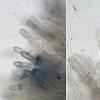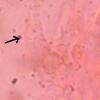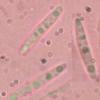
20-12-2025 23:08
Patrice TANCHAUDBonsoir, récolte sur sol sablonneux dans l'arri�

20-12-2025 15:47
Mirek GrycHi.These grew on pine wood that was heavily covere

18-12-2025 21:17
Pol DebaenstThe identification took me to Byssonectria deformi

15-12-2025 07:09
 Danny Newman
Danny Newman
indet. Rutstroemiaceae sp. on unk. fallen leavesMc

19-12-2025 10:10
Patrice TANCHAUDBonjour, récolte réalisée en milieu dunaire, a

18-12-2025 17:23
 Bruno Coué
Bruno Coué
Bonjour,je serais heureux d'avoir votre avis sur c

18-12-2025 18:07
Margot en Geert VullingsThese plumes were found on rotten wood.They strong

17-12-2025 18:35
 Michel Hairaud
Michel Hairaud
Bonjour à tous/Hi to everyone I am passing along
 ... d'une plante herbacée (peut-être une Poaceae).
... d'une plante herbacée (peut-être une Poaceae).Apothécies 0.4-1 mm diam. Marge nettement villeuse.
Poils marginaux clavés dans l'article sommital, distinctement incrustés, 28-46 × 7-10 µm (partie la plus large). Asques sans crochet, 62-70 × 6-7 µm, pars spor. 29-33 µm, anneau apical IKI+ (bb). Paraphyses × 3–4.5 µm. Ascospores 11.5-16 (17) × 1.8-2.5 µm, fusiformes étroites, souvent courbées, contenant plusieurs guttules.
Je n'arrive à rien de concluant en utilisant les clés de A. Gminder ou de Zotto.
Une idée ?
===
Apothecia 0.4-1 mm diam. Margin distinctly villose.
Marginal hairs clavate in the top article, distinctly incrusted, 28-46 × 7-10 µm (wider part). Asci without crozier, 62-70 × 6-7 µm, pars spor. 29-33 µm, apical ring IKI+ (bb). Paraphyses × 3–4.5 µm. Ascospores 11.5-16 (17) × 1.8-2.5 µm, narrow fusoid, often curved, containing several oil-drops.

Did you test KOH?
Zotto
I've collected a similar-looking species from Aberystwyth, Wales, UK from Cortaderia (pampas grass), as part of my PhD thesis.
Based on the ITS DNA sequence my collection seems to be a close relative of what I consider to be Mollisia cf. poaeoides, which colonises turf-grass culms around Aberystwyth and possesses shorter ascospores with similar oil droplets. I suspect the ascospore size difference in the larger-spored species is associated with a host-jump to another larger grass species.
At the moment, it looks like there are many closely related species in this group that are endophytes of grass, orchid and other hosts (based on isolates and environmental sequences from plants). None of these have been collected and sequenced yet, so it is possible that there are other species on similar hosts with similar morphology.
Checking through my images I also can't see any distinct croziers, but I wasn't specifically looking for them when taking the images, and also wouldn't consider this a diagnostic feature at the moment. I didn't observe any KOH reaction.
I've attached a slide of some of my images so you can compare with your collection.
Cheers,
Brian

Be sure that the absence of croziers is an extremely important character, certainly constant within a species of Mollisia or Pyrenopeziza.
In Mollisia I recall M. rosae and M. asteroma as having always simple septate asci. M. prunicola and M. excelsior might be confused with their respective counterparts, but alsways have croziers.
On your photo I cannot see well an ascus base.
Nicolas, did you look for crystals? I have the suspicion that you fungus could be M. retincola, though I have noted a larger spore size in my files.
Zotto

I now compare yours with M. luctuosa = humidicola. That species has 1-septate spores insider the living asci, however, though I am not sure about this in every of the specimens I have in my folder. The macroscopy is very similar at least.
Zotto


I suggest alternatively to make a Melzer mount in which septa are often rather striking. If you find enough asci with septate spores inside this would be a further confirmation for luctuosa.

Good tip :-)
Zotto - I've emailed you regarding my issues with the taxonomic value of croziers (at least in Mollisia and Pyrenopeziza). Hopefully I'm just being stupid and you can correct me!
Cheers,
Brian



 Mollisia AB1
Mollisia AB1

